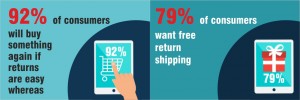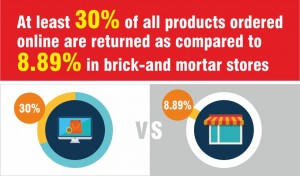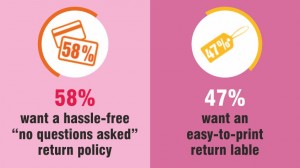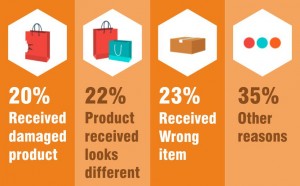Today’s consumer is connected, informed, and has more options for shopping than they can imagine and evaluate. Many customers review a store’s returns and refunds policy before deciding on a purchase. More marketplace exposure means more sales and more returns. There are, however, ways to improve control of online returns in the face of changing customer expectations and marketplace practices. A well thought out and flexible returns policy helps build faith and confidence in the product by the retailer. Tracing how e-commerce platforms handle the returns and keep their customers satisfied.
Online apparel is returned at much higher rates than other e-commerce items. That is why e-commerce apparel retailers are leading the way when it comes to reducing return rates. Studies suggest free shipping entices consumers to spend more online; by offering free returns, consumers are twice as likely to spend more. Frequent promotions or sales are also likely contributing factors to higher return rates. Besides, there are returns for heavily discounted items that were recently purchased.
Online fashion lingerie brand PrettySecrets, which started out in 2012, has product returns up to 15 per cent at present; it means, over 1000 products are returned per day. Bras have the highest return rate because most women don’t know their bra sizes.
Lingerie brand Soie’s major sales are drawn from marketplaces than their own SOIE ecom site. On an average on a weekly basis the brand despatches around 3500 pieces, which include both lingerie and western wear.
On an average one stop shopping destination Intimate Street receives three returns for every 20 orders, which are despatched. The highest return rate is usually on bras, with customer uncertainty at times on their sizing or fit issues.
Shoppers who enjoyed the convenience of fulfilling wish lists by just a simple click of the ‘buy’ button, are now learning that the return process for online purchases can be quite a task. Apparently, frauds and damaged originals account for 10 per cent of all product returns in the domestic online fashion industry, according to reports that came out in late 2017. So, smaller start-ups started fighting back with artificial intelligence and other advanced technology. Overall, about 30 per cent of all fashion products ordered online are returned for various reasons. This translates to related logistics costs of around INR 870 crore a year, as per industry estimates.
Online shopping may be easy, however making returns for those simple buys can be quite troublesome. The reasons include products not delivered because of logistic issues or rejected by a buyer without taking delivery. Shopping online requires very little effort, but shoppers say that the returns are almost never as easy and straightforward.
Every e-commerce transaction is a trust exercise between the consumer and supplier. The ability to view, hold, try on, examine, and test the products is withheld until delivery and accidents or mistakes can happen as well. According to sources, about 95 per cent of those who buy online will purchase again from a merchant who offers a good return or exchange experience.
Benefits of developing and publishing a clear return policy:
It builds trust with the potential customers, helping to demonstrate that they are not being scammed..
- This trust can actually increase sales.
- It clearly documents what customers can expect and why they are allowed to return.
- It communicates the operational policies of the business internally and everyone needs to be on the same page.
There aren’t many successful brick-and-mortar retailers that don’t accept returns and online stores should be no different If a customer doesn’t like a certain purchase, it should not be difficult for them to return the item. The nature of the product (i.e., intimate, clearance, damaged) naturally, determines whether a full-refund, partial, exchange, or perhaps none at all is issued.

The important feature is the website’s policy shouldn’t be hidden away. To ensure this, the return policy should be posted on the website, on customer correspondence, on receipts and even in the package so that it’s easy to review the policy at every opportunity.
Despite these issues, however, since a customer is always a discerning consumer, it is likely to accept or reject a product based on various issues.
According to Shailesh Nigam Director, founder, DesiFirangi.com. the following three issues are important to be considered while selling online:
- Product Quality – The online consumer often purchases after seeing a few nice pictures of the product and the price. He/she assumes a certain quality based on past experience, on the item description or on what is normally expected from a certain kind of product. If the quality of the product is suboptimal, the buyer is quite likely to not only return the product but also give a negative rating and harsh comments on the website that are likely to influence future consumers and impact future sales. Apart from returning the money and losing the sale, the seller would end up losing this customer forever along with many other who read his/her comments. So, it’s important to make sure that products of inferior quality are never delivered ever.
- Product Packaging – This is another critical issue for online sellers as it not only keeps the product safe during the shipping process but can also speak a lot about the brand once the consumer receives it. Hence, use of damage-proof packaging that ensures that the product is absolutely fine when delivered is recommended. A damaged packaging is likely to leave a bad impression on the buyer and may even not be accepted / returned if the product inside is also damaged. Also, an appealing packaging is likely to create a differentiation where hardly any exists in online selling across platforms. So, the little bit of extra expense on packaging should be taken into account and built into the cost, if needed, to enhance the brand image and not just be any unknown seller on a marketplace.
- Speed of Delivery – A very important aspect of any sale is quick delivery. Whether consumers buy from offline or online channels, they expect the product to be with them as soon as they’ve bought it. Obviously, the same is not possible online (barring software delivery). Yet, one has to ensure that the product reaches as soon as possible, using the most reliable logistics partners and the customer gets timely updates about the product during shipment. This not only gives a reassurance to the buyers that the product is reaching them quickly but also ensures that they don’t end up cancelling the order even before it is shipped. Or, even worse, buying a similar product from elsewhere (online or offline) and not receiving the order at all, especially if it is COD (Cash On Delivery) shipment.
Difficulties faced during product returns
Joyjeet Banerjee, Vice President, Inventory and Planning, Pretty Secrets goes on to say, “Unless the product is damaged we refurbish the returned products. Returns are a necessity in towards ecommerce market and we have to deliver the same. Biggest issue is, we are invariably left with dead stock. We inform the market places about these difficulties but in a constant endeavour for better customer experience we have to bear these minor issues. Don’t over discount products.”
“Online platforms should change their return policies, especially on the order above certain billing value so that both vendor and marketplace don’t incur losses. Also, marketplaces are not concerned about product returns more than they’re running to grab on the customer data acquisition. At the end their evaluation is on GMV and customer data metric and not on returns,” says Anuja Mashruwala, Senior Manager, Business Development, Online Sales and Marketing, Soie.
“In our invoice we mention our return policy’s points apart from it being mentioned on our website. These points have to be taken into consideration in case there is a possibility of return. This helps to avoid any unnecessary delay towards full refund or issuing store credit. Unfortunately, they don’t adhere to the same at times and products are returned violating those policy points,” says Ovais Dehlvi, Manager, Operations, Intimate Street.
What do you think of the ‘no questions asked returns policy?
“It makes better customer experience and makes shopping online hassle-free,” comments, Joyjeet Banerjee, Vice President, Inventory and Planning, PrettySecrets.
“Knowing the behaviour and the choices the consumers are spoilt for already, correction in return policy terms will have a great impact on sales which I think any brand can’t afford. A ‘no questions asked’ policy is almost equal to negligible order processing,” states Anuja Mashruwala.
“It is a gamble policy, which can work in your favour and also not. Customers, especially first time buyers are apprehensive on buying a premium product but do take the risk knowing that they can get a refund if he / she doesn’t like the product, which gives reassurance and builds a long lasting customer relationship between the two. On the other hand, with the policy there is a lot of wastage of time and resources, which is an added expense,” explains Ovais Dehlvi.
Do e-commerce returns maximise or minimise losses?
“Any kind of return leads to an increase in losses specially RTVs. We try to stem the same before despatch by offering last minute cancellations to customers. We also work towards high return areas by creating a self ship mechanism for these areas, ” comments, Joyjeet Banerjee, about the losses (if any) incurred through the return policy.
“Of course we try to work to minimise it, like mentioned since we’ve lingerie as a stronger selling category; for us it balances out since we don’t take returns on intimates. But we do analyse on improving returns as per genuine feedback,” comments Anuja Mashruwala.
“Again, it varies for each seller; there are many variables when a seller despatches a product. Be it the packaging, courier charges, product availability, etc. We reduce our cancellation and return rates at the source itself… for each order placed on our website we contact the customer via email and phone to reconfirm the order, which has been placed by them. If any change, the order is cancelled at our end and the customer is refunded the money subsequently in the event of an online payment order,” states Ovais Dehlvi.
Policies and choice of e-commerce platforms
Every brand has its own way of dealing with returns and formulates policies based on mainly their customers’ demands. So, do they choose their online platforms based on the return policy
“We prefer Myntra and Jabong because of higher synergy between PS and these channels,” says Joyjeet Banerjee.
While Anuja Mashruwala comments, “We sell on almost all the mid and giant marketplaces. To name a few, Myntra, Jabong, Flipkart, Limeroad, Nykaa, Amazon and there are more to continue.”
“We work with four marketplaces apart from our own website. They are—Elitify.com, Thebeachcompany.in, Paytm.com, Amazon.in and will be soon be going live on Flipkart.com”
I personally don’t have a favourite, or would say one is better than the other; each portal we work with caters to a different segment of products and clientele. We retail intimate wear products, hence the return policy plays a critical part in the choice of our platform selection. We follow a strict hygiene policy and time duration for return on the product, therefore partner up with people who adhere to the same,” mentions Ovais Dehlvi.
There’s a lot of activity constantly online and brands as well as marketplaces, it seems may need to change their return policies as well. Brands have feel that where intimates are concerned, there marketplaces should frame a separate return policy.
“Each marketplace / online platform is entitled to have their own return policy tailored for their products. But I do feel a separate policy should be in place for intimate wear products if the marketplace site sells across different categories. Specifically on the time window to return an intimate wear product, for example, to have a generic time window allowing the customer to return the product even after a month is not justified,” comments Ovais Dehlvi.
Anuja Mashruwala, too agrees and says, “Yes, especially on the order above certain billing value so that both vendor and marketplace don’t incur looses.”
Customer is king
Online marketplaces, it may seem, follow this age-old adage and favour the customers more than the brands it sells on their platforms.
Joyjeet Banerjee, Vice President – Inventory & Planning, Pretty Secrets says, “Customers should be at the centre of every business and that is the right approach.”
“It’s a totally customer ruled market; if one doesn’t adhere to customer demands, they’ve bundles of options to go to the way newer options are being flooded in this e-commerce world,” feels Anuja Mashruwala.
However, it’s surprising that when online platforms are doing quite well, they are still making their presence felt offline. “it offers a seamless experience to customers across all touch points,” comments Joyjeet Banerjee.

While Anuja Mashruwala, goes on to say, “An omni channel presence always helps to build confidence in the mind of customers. Any single platform selling proposition is no more a viable business for a long term vision.”
“An offline presence builds not only credibility but also assists in solving grievances, especially for brands who have just entered the market with their product. To this date, a lot of well-established brands internationally, still have an offline presence to accept returns on their online orders and not just restrict it to the virtual world.
For example in the case of our premium and luxury intimate wear products, with our price points being a bit higher compared to other prevailing brands in the market, an offline presence allows the customer to have the ‘touch and feel’ experience to assist in their purchase,” explains Ovais Dehlvi.
So, to wrap up, we can say that product returns for online platforms can be quite daunting. Yet, the returns policies, we feel, need to be streamlined further so that the brands do not incur losses while keeping the customers happy as well.
True, an omni-channel presence is beneficial for brands, but if customers are allowed to return the product the way they do under the current policies, there will be a time when brands would have to call it a day and just stop accepting returns.
Whether they would still retain customers or lose them depends on the policies and customer psychology. Also, the online shopping space is a relatively new one in India and needs to evolve further for it to get more organised. So, it seems, it’s only a matter of time until brands decide on some set returns policy to cut back on losses and maintain sales.

























